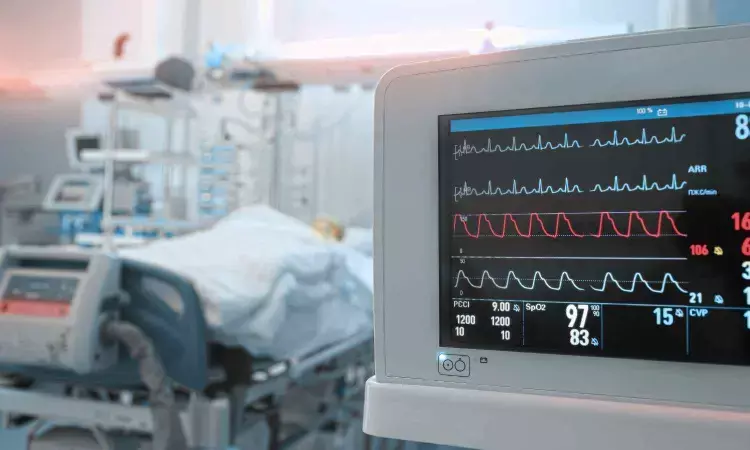- Home
- Medical news & Guidelines
- Anesthesiology
- Cardiology and CTVS
- Critical Care
- Dentistry
- Dermatology
- Diabetes and Endocrinology
- ENT
- Gastroenterology
- Medicine
- Nephrology
- Neurology
- Obstretics-Gynaecology
- Oncology
- Ophthalmology
- Orthopaedics
- Pediatrics-Neonatology
- Psychiatry
- Pulmonology
- Radiology
- Surgery
- Urology
- Laboratory Medicine
- Diet
- Nursing
- Paramedical
- Physiotherapy
- Health news
- Fact Check
- Bone Health Fact Check
- Brain Health Fact Check
- Cancer Related Fact Check
- Child Care Fact Check
- Dental and oral health fact check
- Diabetes and metabolic health fact check
- Diet and Nutrition Fact Check
- Eye and ENT Care Fact Check
- Fitness fact check
- Gut health fact check
- Heart health fact check
- Kidney health fact check
- Medical education fact check
- Men's health fact check
- Respiratory fact check
- Skin and hair care fact check
- Vaccine and Immunization fact check
- Women's health fact check
- AYUSH
- State News
- Andaman and Nicobar Islands
- Andhra Pradesh
- Arunachal Pradesh
- Assam
- Bihar
- Chandigarh
- Chattisgarh
- Dadra and Nagar Haveli
- Daman and Diu
- Delhi
- Goa
- Gujarat
- Haryana
- Himachal Pradesh
- Jammu & Kashmir
- Jharkhand
- Karnataka
- Kerala
- Ladakh
- Lakshadweep
- Madhya Pradesh
- Maharashtra
- Manipur
- Meghalaya
- Mizoram
- Nagaland
- Odisha
- Puducherry
- Punjab
- Rajasthan
- Sikkim
- Tamil Nadu
- Telangana
- Tripura
- Uttar Pradesh
- Uttrakhand
- West Bengal
- Medical Education
- Industry
mCC/eGFR Ratio: A New Indicator of Muscle Mass and Mortality Risk in ICU Patients, Study Finds

Delhi’s GTB Hospital to Redistribute Surplus Medical Equipment
Netherlands: A recent study published in BMC Nephrology has shed light on the modified creatinine clearance/eGFR (mCC/eGFR) ratio as a potential indicator of musNetherlandscle mass in intensive care unit (ICU) patients, with significant implications for predicting mortality.
The findings showed that the mCC/eGFR ratio correlates with both in-hospital and long-term mortality, making it a readily accessible measure of muscle mass in ICU patients.
"In-hospital mortality rates were 27% for patients in the lowest mCC/eGFR quartile, compared to just 11% in the highest quartile. Five years after discharge, the mortality rate remained elevated at 37% for those in the lowest quartile, while it dropped to 19% for those in the highest," the researchers reported.
Muscle mass is a critical factor in the health of ICU patients, influencing their recovery trajectory and overall prognosis. Loss of muscle mass, or cachexia, is commonly observed in critically ill individuals, and it has been linked to poorer outcomes. While muscle mass can be assessed using 24-hour urinary creatinine excretion (UCE), its effectiveness for predicting risk in individual patients is hindered by the absence of age-, sex-, weight-, and length-specific reference values for UCE. The ratio of measured creatinine clearance (mCC) to estimated glomerular filtration rate (eGFR) may help address this limitation.
In response to these insights, Meint Volbeda, Department of Critical Care, University of Groningen, University Medical Center Groningen, Groningen, The Netherlands, and colleagues aimed to evaluate the relationship between the mCC/eGFR ratio in ICU patients and both all-cause hospital mortality and long-term mortality.
For this purpose, the researchers calculated the mCC/eGFR ratio in patients admitted to the ICU between 2005 and 2021, specifically those with KDIGO acute kidney injury (AKI) stages 0–2 and an ICU stay of 24 hours or longer. The mCC was derived from urinary creatinine excretion and plasma creatinine levels, then indexed to 1.73 m². The mCC/eGFR was analyzed by dividing patients into quartiles and treating it as a continuous variable.
The study led to the following findings:
- A total of 7,509 patients were studied (average age 61 years; 38% female).
- In-hospital mortality was 27% for those in the lowest mCC/eGFR quartile, compared to just 11% in the highest quartile.
- Five years after hospital discharge, mortality was 37% in the lowest quartile and 19% in the highest.
- The mCC/eGFR ratio, when treated as a continuous variable, was independently linked to in-hospital mortality in multivariable logistic regression, with an odds ratio of 0.578. This ratio was significantly related to five-year post-discharge mortality in Cox regression analysis, with a hazard ratio of 0.27.
The authors suggest that the mCC/eGFR ratio could be a valuable tool for estimating overall muscle mass in ICU patients, irrespective of demographic factors, and is independently associated with both in-hospital and long-term mortality.
"Future studies may further clarify the utility of the mCC/eGFR ratio in clinical practice," they concluded.
Reference:
Volbeda, M., Zijlstra, H.W., Post, A. et al. Creatinine clearance/eGFR ratio: a simple index for muscle mass related to mortality in ICU patients. BMC Nephrol 25, 330 (2024). https://doi.org/10.1186/s12882-024-03760-2
Dr Kamal Kant Kohli-MBBS, DTCD- a chest specialist with more than 30 years of practice and a flair for writing clinical articles, Dr Kamal Kant Kohli joined Medical Dialogues as a Chief Editor of Medical News. Besides writing articles, as an editor, he proofreads and verifies all the medical content published on Medical Dialogues including those coming from journals, studies,medical conferences,guidelines etc. Email: drkohli@medicaldialogues.in. Contact no. 011-43720751


